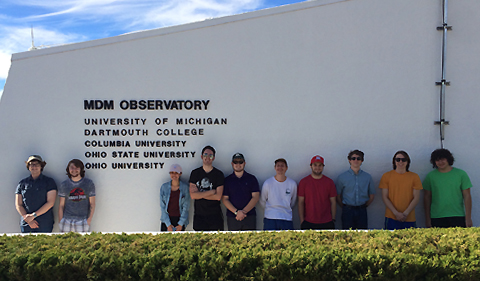By Daniel Ivory
(B.S. Applied Physics, College of Arts & Sciences, Class of 2020)
Editor’s Note: Ohio University researchers obtain astronomical images for both research and class work using the 1.3 meter McGraw-Hill telescope at MDM Observatory on Kitt Peak in Arizona. We process and calibrate these images using an old, but well tested, software package known as IRAF. The goal of this project was to write a new pipeline in the python language to modernize our processing of MDM images.
My summer internship with Dr. Ryan Chornock was to develop and test a modern image reduction pipeline for both use in his research and for students who take the ASTR 3251 course which introduces students to the image reduction process. This was done with the widely popular programming language, Python.
During this internship, I not only gained a deeper understanding of Python programming, I was also introduced to the World Coordinate System which is used when processing astronomical image files and makes images easier to manage due to having a solid reference point.
If time had allowed, I would have attempted to optimize my code and double check that everything was neatly formatted. In addition, I would have also looked more into troubleshooting a problem I encountered where a particular subroutine was not working, as the workaround was rather messy from a coding standpoint.
One challenge was the incorporation of the World Coordinate System (WCS) as used in astronomy. When I came upon incorporating such a feature to what I already had, I encountered the problem of not being able to query an online database easily with the Python libraries I was using. While this code is still good for image reduction, this additional step required a rewrite using different libraries so that the precision and scope of an online database could be harnessed.
I met with Dr. Chornock once a week in most cases on Thursdays in his office. These meetings were mainly to check on my progress and to assign additional steps as necessary to make this a more useful project. Dr. Chornock was away for several weeks during this summer due to travel and conferences, but he was always available by email if I needed any advice.
My topic was particularly interesting to me because while I love programming, the programs I have written for classes are not of much use. This summer I got to work on something that would not only be helpful to Dr. Chornock in his research, but give students taking ASTR 3251 course a different view at how we process images in astronomy using modern programming languages. This not only combined my love of programming and astronomy into a project, but also made me feel like I had a positive impact on the learning outcomes of students and the productivity of Dr. Chornock here at Ohio University.
I would advise any incoming internship students to not be afraid to ask questions or even repeat them if needed. My experiences with professors is that they are genuinely interested in a student’s learning and will contribute a great deal when a student comes forward with questions or concerns.





















Comments